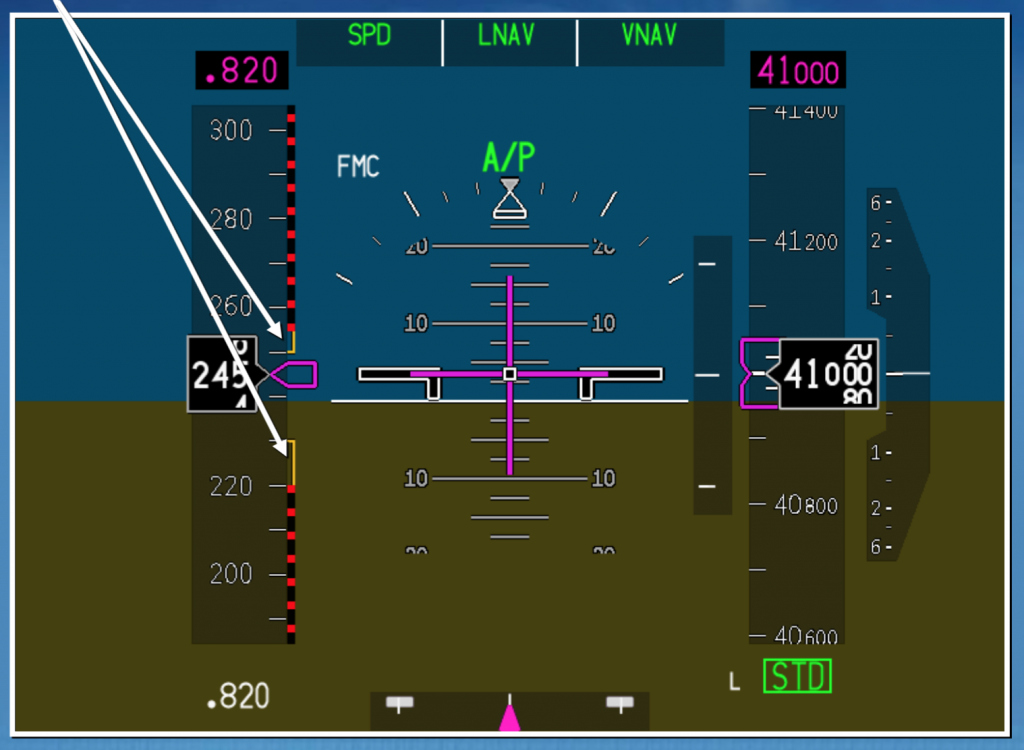Coffin Corner – “The flight regime where any increase in airspeed will induce high-speed Mach buffet and any decrease in airspeed will induce low-speed Mach buffet.” – FAA Airplane Flying Handbook
From a pilots point of view coffin corner (also called Q-Corner or aerodynamic ceiling), is when the high-speed limit and low-speed limit on your airspeed come together as your altitude increases.
In the below image you can see the high speed and low-speed tapes converging.

If the aircraft climbed to a higher altitude, these speed tapes would continue to become closer together, leaving less window to maneuver within.
In a jet, as your altitude increases, the maximum speed (redline, barber-pole, or MMO) will decrease. The minimum airspeed (low-speed buffet, stall speed, or min speed tape) will increase. The higher you climb the closer these minimum and maximum speeds become. The point at which they converge or nearly converge is called “coffin corner.”

A pilot of the U2 flying at 60,000 feet only has a margin of six knots between its high speed and low-speed limits. (Source: The U2 History Declassified)
This can be a very dangerous region of the flight envelope because there is little room for error. If the aircraft over-speeds, there is a possibility of Mach tuck causing the nose of the aircraft to drop, increasing speed even more exceeding structural limitations, and breaking apart. Going too slow could cause a stall, potentially causing the nose to drop, which could also increase the speed to the point of structural failure.
Some interesting points to consider about coffin corner:
- In coffin corner, either speeding up or slowing down will cause a buffet.
- It may not be possible to tell the difference between a stall buffet and a Mach buffet, and attempting to recover inappropriately would aggravate the situation.
- Becoming too slow may actually cause Mach buffet and not a stall buffet. The increased angle of attack causes air to flow faster over the wing potentially hitting Mach sooner.
- Mach buffet is a function of the speed of air over the upper portion of the wing, not the airspeed of the airplane.
- If any load factor is imposed (pulling up, turning, or turbulence) it will cause the airspeed margin to become even smaller.
- A heavy aircraft will reach coffin corner sooner – Higher weight lowers the altitude which coffin corner occurs.
- The original term Q-Corner refers to “Q” being the symbol for dynamic pressure.
How to avoid Coffin Corner
- Always be aware of, and comply with all aircraft operating limitations!
- Don’t climb a heavy aircraft higher than the published max altitude for that weight.
- Avoid abrupt control inputs, steep turns, or pulling G’s at high altitudes. Even moving the heading bug to prompt an autopilot turn can induce Mach buffet on some aircraft when you are close to coffin corner.
- If turbulence is expected, don’t climb to your maximum altitude.
- Don’t attempt to climb over a storm – Go around it! The increased load factors caused by turbulence could cause you to stall, or Mach tuck, down into the storm.
- Pay attention the published turbulence penetration speed. This speed is often calculated as being the highest margin between high and low-speed buffet.
Remember, stall and Mach buffet are not the only limiting factors at high altitudes. On October 14, 2004, Pinnacle Airlines Flight 3701 climbed too high for their current weight, attempting to join “The 410 Club” on an empty reposition leg. Due to exceeding the aircraft’s published climb limitations, both engines overheated failed, and the aircraft eventually crashed, killing both crew members.
